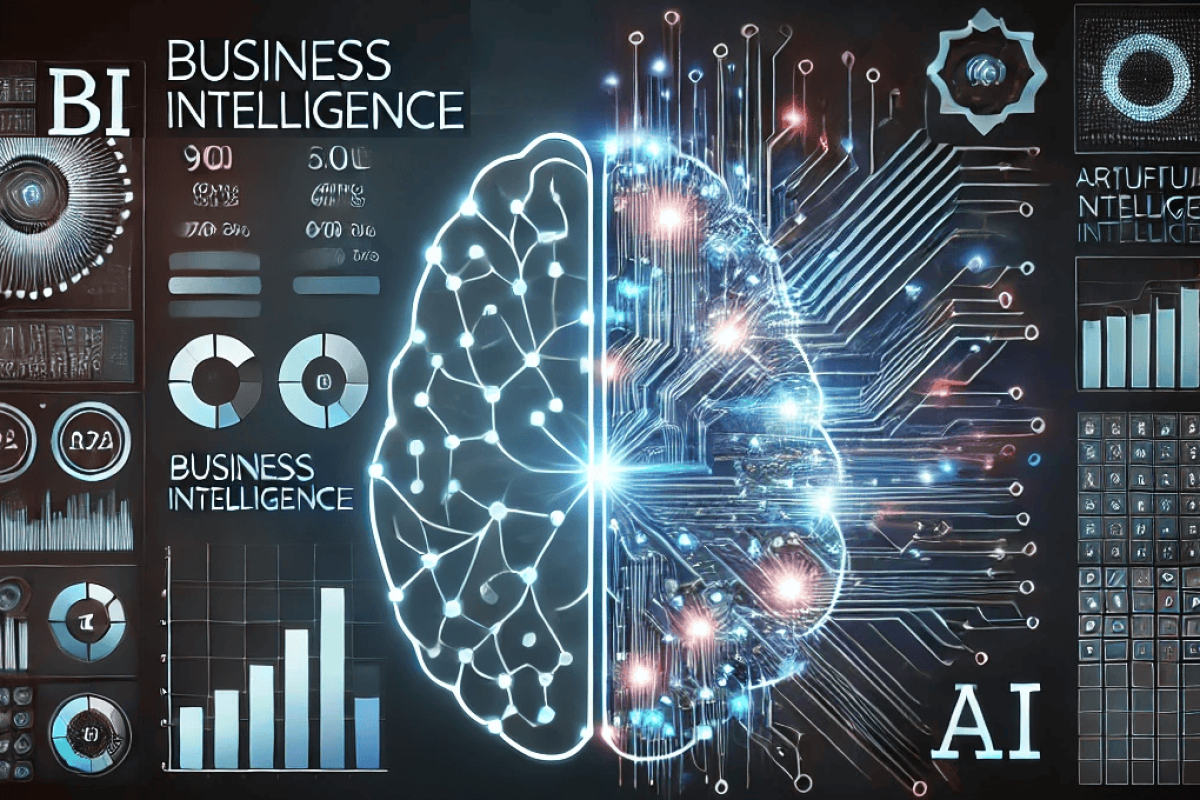Business Intelligence (BI) has long been the backbone of modern organizations, guiding executives through an ever-growing labyrinth of data. Today, another technology is clamoring for the spotlight: artificial intelligence (AI). While many have predicted AI would eclipse BI, a powerful synergy is actually emerging between the two. BI is helping organizations lay the vital groundwork for AI’s success—ensuring the best data is collected, organized, and primed for advanced analytics. At the same time, the adoption of AI is raising the bar for data preparation and governance, fueling more sophisticated and insightful BI tools and dashboards. In essence, each effort reciprocally supercharges the other, creating a virtuous cycle of data maturity that propels enterprises into a new era of fact-based decision-making.
The Data Gold Rush
Over the past decade, data has been hailed as the “new oil,” a resource so essential that it underpins nearly every aspect of an enterprise. From supply chain optimization to customer relationship management, data flows from myriad sensors, transactions, and interactions. But like crude oil, data is only valuable when refined. Enter BI, the discipline that extracts meaning from raw numbers and weaves it into actionable insights. Thanks to these BI processes—cleaning, blending, transforming—data turns from unstructured reams of information into dynamic dashboards, KPI reports, and visualizations that help business leaders navigate with greater clarity.
AI brings a fresh layer of excitement to this data revolution. Where BI has traditionally focused on descriptive and diagnostic analytics—what happened and why it happened—AI catapults organizations into predictive and prescriptive analytics: what will happen and what should we do about it. Yet to perform at its peak, AI needs huge volumes of well-structured, error-free data. That is precisely where BI shines. The more robust an organization’s BI infrastructure, the more readily its data can be fed into machine learning (ML) algorithms. And the better the data, the stronger and more accurate the AI-driven insights become.
Building the Foundation for AI
In many ways, BI initiatives pave the road for AI. When companies embark on a BI transformation—implementing data warehouses, enforcing governance policies, building data catalogs—they are inadvertently ticking items off an AI wish list. For instance, a well-designed BI environment enforces standardized data definitions across different departments. If the finance team calls a field “net revenue” while the sales team calls it “net_sales,” confusion arises that could upend an AI model’s accuracy. BI best practices ensure that everyone uses consistent terminology and adheres to a common data dictionary. This standardization is critical for AI algorithms to avoid spurious correlations and erroneous recommendations.
Additionally, BI projects illuminate data quality issues that might otherwise remain hidden until it’s too late. A classic example: duplicative or incomplete customer records that appear harmless in small-scale reporting but cause havoc in AI-driven personalization. By cleansing and validating data at the BI stage, companies reduce the risk of deploying faulty AI solutions that generate misleading predictions. BI’s emphasis on data lineage—tracing the origins of each data element—also gives AI teams a head start in understanding the heritage and reliability of the numbers. Essentially, every step taken to improve BI readiness pays dividends when it’s time to deploy AI.
AI Giving Back to BI
If BI lays the foundation for AI, AI returns the favor by supercharging BI. How? Consider the simple act of generating dashboards. Traditional BI tools rely on human expertise to decide which metrics matter, how to filter results, and when to drill down. AI can transform these once-manual processes with automated insights. Rather than limit exploration to predefined filters, AI-driven BI tools can sift through mountains of data, spotting trends and anomalies that might elude human eyes. A spike in customer churn, a regional supply chain bottleneck, or a curious uptick in product returns—these are all patterns AI algorithms can surface autonomously, alerting teams to potential issues before they balloon into crises.
Moreover, AI can personalize BI dashboards for different user groups. Sales reps might see AI-driven lead scoring models and pipeline dashboards, while product managers see forecasts for user adoption rates. Executives, meanwhile, can view AI-summarized narratives—paragraphs of text that encapsulate key insights so they can skip flipping through charts. The synergy goes deeper: natural language processing (NLP) can power next-generation BI interfaces, allowing executives to simply ask, “Which product categories are driving the most profit in Southeast Asia this quarter?” and receive dynamic charts and answers in real time. As organizations embrace AI, they effectively level-up the usability and intelligence of their BI tools, making analytics accessible to an ever-wider audience.
Breaking Data Silos
A central challenge for both BI and AI is data fragmentation. Traditional enterprises accumulate siloed data across departments: marketing, finance, HR, logistics, and more. BI projects typically fight this silo phenomenon by establishing enterprise data warehouses or data lakes, building standardized schemas, and enforcing governance protocols. This approach sets the stage for AI initiatives that rely on cross-functional data to detect global patterns. For example, machine learning models that predict customer churn often need data from sales, support, and product usage logs—a combination that rarely resides in a single silo.
When organizations rush toward AI without first addressing their silo problem, they risk building incomplete models that fail to account for vital signals. However, if they have already tackled data integration for BI, they can more quickly unify these resources for training AI models. Conversely, once an AI project demonstrates the success of cross-departmental collaboration—say, a marketing campaign that soared because the AI model had deeper insights—stakeholders become even more motivated to maintain and improve the integrated data platforms. Ultimately, BI’s data integration frameworks and AI’s thirst for cross-functional datasets create a perfect feedback loop, leading to more robust, holistic analytics across the enterprise.
Governance as the Unsung Hero
While technology visionaries often talk up breakthroughs in deep learning and advanced analytics, the less glamorous domain of data governance can make or break both BI and AI projects. Governance frameworks establish rules for data quality, metadata documentation, access controls, and compliance. These guidelines are crucial for BI reporting, where even minor discrepancies can undermine trust in the numbers. They become even more pivotal for AI. In many industries—finance, healthcare, and beyond—stringent regulations govern how data can be used, stored, and shared. Without robust governance, organizations may spend months building an AI model, only to find it runs afoul of data privacy regulations or compliance guidelines.
Thus, governance becomes a central pillar that supports both BI and AI. Every step taken to improve data privacy compliance and regulatory alignment enhances confidence in the final analytics and predictions. Equally, as companies expand their AI projects, they must refine governance practices to address complex ethical issues, such as algorithmic bias. These refined practices then loop back into BI, raising overall data standards and reinforcing best-in-class data stewardship across the entire enterprise.
Culture Shift: From Reports to Real-Time Decisions
Neither BI nor AI can fully flourish unless an organization embraces a data-driven culture. Historically, BI reports were often relegated to monthly or quarterly reviews, used mostly for post-mortem analyses. AI, with its predictive power, nudges companies to adopt real-time or near-real-time decision-making. This cultural shift has a ripple effect on BI: dashboards evolve from static scorecards to dynamic, constantly updating tools that reflect the pulse of the business.
For example, a retailer can track minute-by-minute sales and inventory data, adjusting promotions mid-day based on emerging insights. The deeper and timelier the data pipelines, the more sophisticated both BI and AI become. Yet this requires a collective mindset that views data not as a historical record but as a living asset—one that shapes proactive strategies. Organizations that implement AI-driven automation for tasks like demand forecasting, sentiment analysis, or fraud detection often see an immediate need for accurate, up-to-the-minute dashboards. That necessity accelerates the modernization of BI tools, fostering a synergy in which AI and BI efforts become mutually reinforcing.
Preparing for Tomorrow
The race to adopt AI might feel frenetic. From predictive maintenance in manufacturing to personalized medicine, the possibilities seem endless and urgent. But as corporations rush to plug in machine-learning solutions, the ones that succeed remember this guiding principle: you cannot unleash AI’s full potential without a mature BI ecosystem. That ecosystem involves rigorous data management, governance, user-friendly reporting tools, and a culture that trusts data. And while BI serves as the runway for AI’s takeoff, AI doesn’t just fly off on its own; it circles back, dropping new capabilities, automation, and insights that push BI to its next generation of relevance.
Tomorrow’s winners will be those who recognize and nurture this symbiotic relationship. BI is AI’s best friend, ensuring the data is well-structured, accurate, and accessible. AI is BI’s best friend, returning the favor by adding predictive powers, dynamic insights, and an impetus to continually refine data foundations. This cycle—data refinement through BI, innovation through AI, and then enhanced BI—propels organizations toward true data mastery. In an era defined by information overload, harnessing that synergy could be the ultimate competitive advantage.




